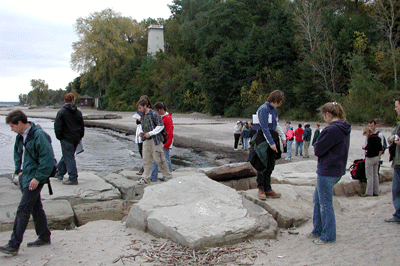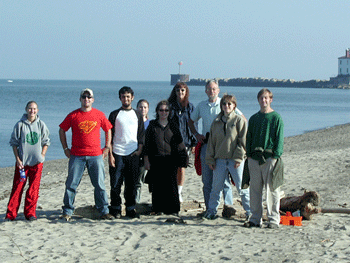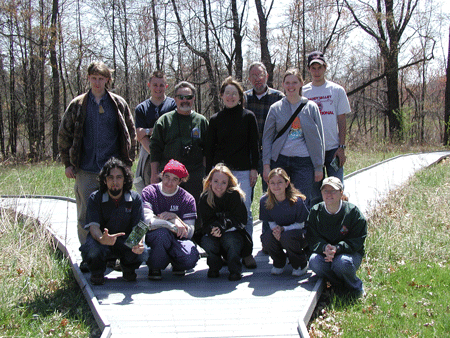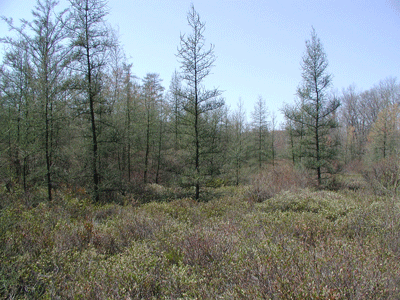On our Field Trips you can:
| Explore local geology and paleontology | |
| Visit local museums | |
| Collect rocks and minerals | |
| Visit working geological locations such as mines and landfills | |
| Have fun! |
Click on the trip you wish to see!

Dr. Joe Hannibal, center, speaking to students at the Cleveland Museum of Natural History, March, 2006
March 2006
Cleveland Museum of Natural History
Students had the opportunity to go behind the scenes to see the research areas of the museum. Dr. Joe Hannibal, Curator of Invertebrates, gave students a tour of the display area of the museum as well as the research area.
Get more information on the Museum
Lake Erie Coastal Erosion: Cascading cliffs and shifting sands
Saturday October 9, 2004
Join Geology Club and the Northern Ohio Geological Society field trip to the Lake Erie coastline. Don Guy of the Ohio Geological Survey, a noted authority on the subject, led the trip.
20 KSU students, professors, and visiting scientists attended the field trip. Students were able to observe coastal erosion and remediation efforts such as breakwalls and jetties in place. In addition, students were able to observe glacial tills in place, zebra mussels, freshwater molluscs, and fossiliferous limestones used as riprap for coastal protection.
Our thanks to Don Guy for leading such a fantastic trip!

Students studied coastal erosion at 4 locations along Lake Erie west of Cleveland, starting in Avon Lake and ending at Sheldon Marsh State Nature Preserve near Cedar Point. Photo by R. Feldmann.

Students at Mentor Headlands State Park, along Lake Erie, east of Cleveland, Fall 2003. Photo by J. Tolin.
Fall 2003
Mentor Headlands State Park, along Lake Erie, east of Cleveland
Students visited the State Park and Painesville Township Park to explore coastal erosion and accumulation of sand. Wave refraction, longshore drift, undercutting, erosion remediation, and other coastal phenomena are easily observed at these parks.

Kent Bog, Kent, Ohio. Photo supplied by J. Tolin.
April 2003
Jackson Bog and Kent Bog State Nature Preserve
Students visited these bogs in April, 2003. Emliss Ricks, State Nature Preserve Manager, led the tours for the Club. Both bogs are remnants of the Ice Ages in Ohio, but they have different chemistries and floras. The Jackson Bog is actually a fen, meaning that the water is basic or neutral.
April 2003
Kent Bog State Nature Preserve
The Kent Bog is a true bog, with acidic water. It supports the largest stand of Tamarack trees this far south. Tamarack trees are conifers that lose their needles each year. The Kent Bog is located on Meloy Road, just south of Kent on St. Rt. 43.
